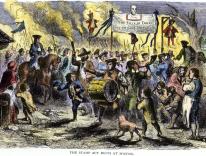Editor’s Note: This article is part of a symposium titled “Abortion after Dobbs.” We asked seven Commonweal contributors, from various backgrounds and with various views, to discuss what the Supreme Court’s recent decision is likely to mean for abortion law, American politics, and the creation of a “culture of life” worthy of the name.
The 1850s were a rough time in American history. The historian James McPherson recounts the story of a jury that convicted a slave trader who had illegally imported slaves from Africa (the trade had been banned since 1808). The jury was subjected to such vicious public threats that they collectively issued a public recantation of their verdict. In it, they distanced themselves from the “pretended philanthropy and diseased mental aberration of ‘higher law’ fanatics.” The term “higher law” had become a common term used by radical abolitionists to justify their refusal to follow mandates like the Fugitive Slave Act. Obviously, the scare quotes were intended to suggest how skeptical these Southerners were toward any appeal to a higher law. And it wasn’t only Southerners who defined abolitionists as fanatics. In 1863, “Peace Democrats” in the North sought to strike a compromise with the South instead of, as they put it, causing further “bloodshed to gratify a religious fanaticism.”
In the period between 1853 and 1863, it was not obvious that the position of radical abolitionists—that all slaveholding should be outlawed and that former slaves should be granted an equality of civil freedom—would ever prevail. Certainly, in the 1850s, this position was quite outside the mainstream. Lincoln even spent the first years of the Civil War insisting that his aim was not to end slavery or enact Black equality. Indeed, certain anti-slavery extremists like John Brown were constantly held up as proof of the violent nature of this religious fanaticism; lurid descriptions of what would happen if abolitionists had their way ratified the worst Southern fears. Gradually, the outrageous behavior of many pro-slavery fanatics, especially those zealous to expand slavery to the territories using any means necessary, nudged both politicians and ordinary citizens toward the abolitionists’ side. Still, it’s safe to say that the more common view of slavery was a kind of ambivalence. Most Americans certainly did not hold slaves, but their distaste for slavery stemmed as much from an idealization of the nobility of honest “free labor” and a resentment of the power exercised by Southerners in national politics as it did from any sense that slavery was wrong. Nor did many really know what would happen after slavery ended. Even among the slaveholding Founders, there was clearly an intention to manage a kind of gradual disappearance of slavery. But how, exactly? Would former slaves be sent back to Africa, as some thought? Most citizens of antebellum America, in the North as well as in the South, would not have endorsed racial equality. The pity of many white Americans was aroused by accounts of the inhumanity of slavery, like in Uncle Tom’s Cabin. But this pity was not always accompanied by respect for Black civic equality.
How, then, did a minority holding a view outside the mainstream and derided as “religious fanatics” within a divided and ambivalent culture finally win the day? And what exactly constituted “winning”? These are really the two questions that all opponents of abortion ought to be asking themselves in the wake of Dobbs. As Alasdair MacIntyre writes, “the history of any society is in key part the history of an extended conflict or set of conflicts,” most importantly about justice, but also inevitably about the moral reasoning of the society in general. The enslavement of Black people and the subsequent history of racial injustice is one such defining conflict about justice and natural rights; abortion has surely become another. We must not imagine that the conflict is of marginal importance because voters may now be more concerned about, say, inflation. The issue of slavery was not a central one in the minds of many ordinary people in the 1850s. But by then, there had already been decades of struggle between two groups of cultural elites for whom the issue had particular moral importance, and that struggle was only intensifying.
There are more parallels between the antebellum conflict over slavery and the current conflict over abortion than people might realize. As with slavery then, abortion itself already appears to be in slow decline, but that fact has not dampened the debate. The position of activists on each side has hardened. Abortion advocates have increasingly turned away from an apologetic tone about “difficult choices” toward a confrontational demand for reproductive rights “without apology,” just as Southerners went from being content with accommodations of their “peculiar institution” to claiming their absolute right to their “property.” As with slavery, we are now facing a situation in which states have radically different legal regimes—and in which one kind of regime is morally repugnant to those affirming the other kind. This is not like a difference over income-tax rates or business regulations. Meanwhile, as with slavery in the 1850s, there’s a larger cultural ambivalence about abortion, one which is particularly apparent in purple states, just as it was then particularly apparent in “border states.” While there wasn’t a lot of doubt about slavery in either Vermont or South Carolina, it was a different story in Maryland or Tennessee.
Finally, the most important parallel: like the nineteenth-century abolitionists, abortion abolitionists are ultimately right, even if theirs is an “inconvenient truth.” Modern embryology textbooks teach that a new organism begins at conception, one that is genetically distinct from either parent and whose development as a particular human is directed from within. With this knowledge of genetics and of fetal development, it is clearer than ever that attempts to draw a fundamental line at any stage in fetal development—there life is, but here it is not—are arbitrary, at least scientifically. Along these lines, Pope Francis famously analogized abortion to “hiring a hit man” to take care of a problem, a remark he repeated in the wake of Dobbs. Euphemisms like “reproductive justice” and dystopian scaremongering about a theocratic “Gilead” distract from what’s really going on in the specific act of abortion, just as the Southern evasions about “property rights” and scaremongering about the social chaos of freeing Blacks were meant to distract from the fundamental moral question: the incompatibility of “liberty and justice for all” with the practice of bondage and inequality for some.
Still, it is one thing to be morally right about a key question of human dignity; it is very much another thing to have a plan for what will happen when the laws change. Here we find another parallel with slavery, perhaps the one that should concern us most. Most Northerners, even Lincoln himself, were quite hazy on the question of what society might look like after slavery. Just as today’s polls show public ambivalence about particular cases of and restrictions on abortion, it seems that many Americans in the 1850s were uncomfortable with slavery and would have welcomed its disappearance, but most did not think that full civil equality of the races was desirable or even possible. That lack of clarity about what should happen after slavery still haunts American society, especially the descendants of those who were held in bondage.
While many of those who welcome Dobbs loudly (and earnestly!) call for large-scale assistance for pregnant women and mothers, the real test will come once it becomes clearer what America might look like with hundreds of thousands of new babies every year, babies whose mothers may not really want the child, babies whose mothers are often single women living in poverty. Further, there remains considerable evasion on the part of some pro-lifers about how such laws might actually be enforced without confirming the dystopian fantasies of pro-choicers. Add our broken health-care system and a wildly unequal school and childcare system that reinforces privilege and disadvantage, and one may begin to get a sense of the mountains pro-lifers will have to move in order to make good on their commitment to the dignity and value of every human life.
My hope is that the primary message of the Supreme Court in Dobbs—America, stop expecting the court to solve your intractable conflicts, and deal with them democratically in your legislatures—will lead to bipartisan attempts to address these serious problems, which affect the common good in ways that go well beyond their relationship to abortion. Moreover, I do believe that states can serve as good social laboratories for experiments in improving the core systems of our society.
However, there is always the danger that a deep moral zealotry (on either side) about a complicated social problem can sabotage the best efforts to work gradually through its complexities. The Civil War did not in fact end “with malice toward none,” and the moral zeal of both racists and their adversaries persisted—and indeed, still persists, albeit in different guises. With both abortion and any kind of racial discrimination, the Catholic moral position is clear. But the way forward through a fragmented society and the fallen human condition is far less clear. More than anything else, we have to figure out ways to walk forward together. Moral clarity too often turns into a zealotry that would make this impossible: you don’t walk forward with a mortal enemy, you march against him. Our nation has been suffering from unhealed racial wounds—and inflicting plenty of new ones—ever since the Civil War ended, with the burden falling most heavily not on the abolitionists or the former slaveholders but on the former slaves themselves and their offspring. So too will it be for a generation of women and children unless the fifty-year movement for the abolition of abortion is now matched by a collective effort to forge an alternative social framework.
The adjective “historic” is overused, but it’s safe to say that Dobbs is historic. It is historic because it stands as a clear marker in an ongoing set of conflicts over who we are as a nation and over what our fundamental moral principles are. And yet history warns us that the real mountain to climb still lies ahead, as we struggle not to end something but to begin something new, a true culture of life—a culture where, in the words of St. Paul VI, “every life is a vocation.”
——
RELATED:
Please email comments to [email protected] and join the conversation on our Facebook page.
Previous Story
The Power to Serve
Next Story
End It Now


